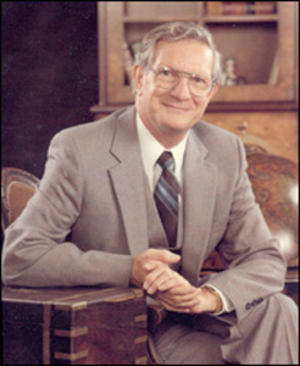
Howard Vincent Malmstadt, faculty of the Department of Chemistry at the University of Illinois from 1951 to 1981, was widely considered the father of modern electronic and computerized instrumentation in chemistry.
Malmstadt was born in Marinette, Wisconsin, on February 17, 1922. He received his BS degree from the University of Wisconsin in 1943, carrying out undergraduate research in organic chemistry under Professor A. Wilds. Upon graduation, he was commissioned as an ensign in the US Navy and attended naval electronics and radar schools at Princeton, MIT, Bell Labs, San Diego Fleet School, and Pearl Harbor. From 1944 to 1945, he served as a navy lieutenant aboard the USS Wilkes DD441, destroyer division in the Pacific, as a radar officer, and upon returning to the States was supervisor for the Department of Electronics Fundamentals at the Naval Radar School on Treasure Island, California.
After being released from the Navy with the rank of senior lieutenant in 1946, he returned to the University of Wisconsin for graduate work and received an MS degree in 1948 and a PhD degree in chemistry in 1950 for his thesis "High Frequency Titrations." His graduate work was conducted under the direction of Walter J. Blaedel. The following year he remained at Wisconsin as a post-doctoral research associate.
He joined the faculty at the University of Illinois as an instructor in 1951, and was promoted to assistant professor in 1954, to associate professor in 1957, and to full professor in 1962. Malmstadt's major areas of research were in emission and absorption spectrochemical methods, precision null-point potentiometry, automatic titrations, and automation of analytical methods. He is generally considered to be the father of modern electronic analytical instrumentation. He introduced thousands of scientists to electronic methods of scientific data collection through his book "Electronics for Scientists" (co-written with his former student C. G. Enke). With Enke, he developed and taught both one-semester and three-week summer courses on electronic instrumentation, the latter financed by industry and the NSF, and materials developed for this course came to be used in more than 500 schools all over the world.
Malmstadt patented a design for a titration apparatus, which from 1954 was manufactured by Sargent and sold bearing his name. In late 1963, the Heath Company began selling the Malmstadt-Enke Instrument Station, which was a package of modules that provided a variety of analytical tools. The station was developed by Malmstadt as a teaching device that enabled students to assemble the various parts of an instrument and thus gain a better understanding of the basic principles involved. At about the same time, Heath also began selling a pH meter based on Malmstadt's design. He wrote more than 150 scientific articles and ten internationally used textbooks.
He served as president of the University of Illinois ACS Section, and as faculty advisor for the Phi Lambda Upsilon chemical honorary fraternity. He was sometimes referred to as "High Voltage Malmstadt" by his chemistry students and colleagues at the University of Illinois, where his prolific ideas and energy were nearly legendary.
Malmstadt was a Guggenheim Fellow in 1960, and received the ACS Award in Chemical Instrumentation in 1963, the Donald P. Eckman Education Award of the Instrument Society of America in 1970, the ACS Award in Analytical Chemistry in 1976, the ISCO Award for Significant Contributions to Instrumentation for Chemical Separations in 1980, the ACS J. Calvin Giddings Award in Education in 1984, the Anachem Award of the Federation of Analytical Chemistry and Spectroscopy Societies in 1987, and the Hasler Award of the Spectroscopy Society of America in 1995.
Brian R. Strohmeier, Chairman of the Hasler Award Committee, stated that "Professor Malmstadt made immense contributions to analytical chemistry, especially in the areas of atomic and molecular spectroscopy, both as an educator and a researcher...he is well known for his brilliant scientific intellect, nurturing personality, high moral standards, enthusiasm, creativity, and leadership in analytical chemistry. The world of atomic spectroscopy today is largely a result of the many generations of students that he has mentored."
Larry Faulkner, former Head of the Chemistry Department at the University of Illinois and currently President of the University of Texas, said "Howard Malmstadt was at least a decade ahead of others in understanding the great qualitative changes that could occur in analytical chemistry by taking advantage, first, of the advances in microelectronics and, later, by the new technology resting on microprocessors. Malmstadt also anticipated the explosive growth that would occur in clinical analytical chemistry."
Malmstadt retired from the faculty at the University of Illinois in 1978, and moved to Hawaii in 1981 to co-found the Pacific and Asia Christian University, which was renamed the University of the Nations in 1989. He served as International Provost and later as International Chancellor of the University of the Nations, which currently has about 300 branch locations in 90 countries.